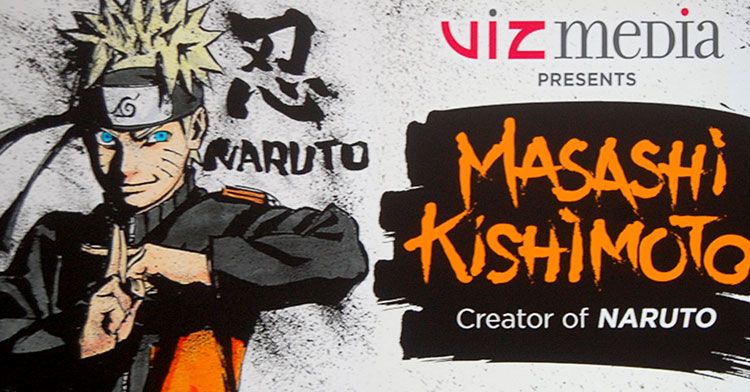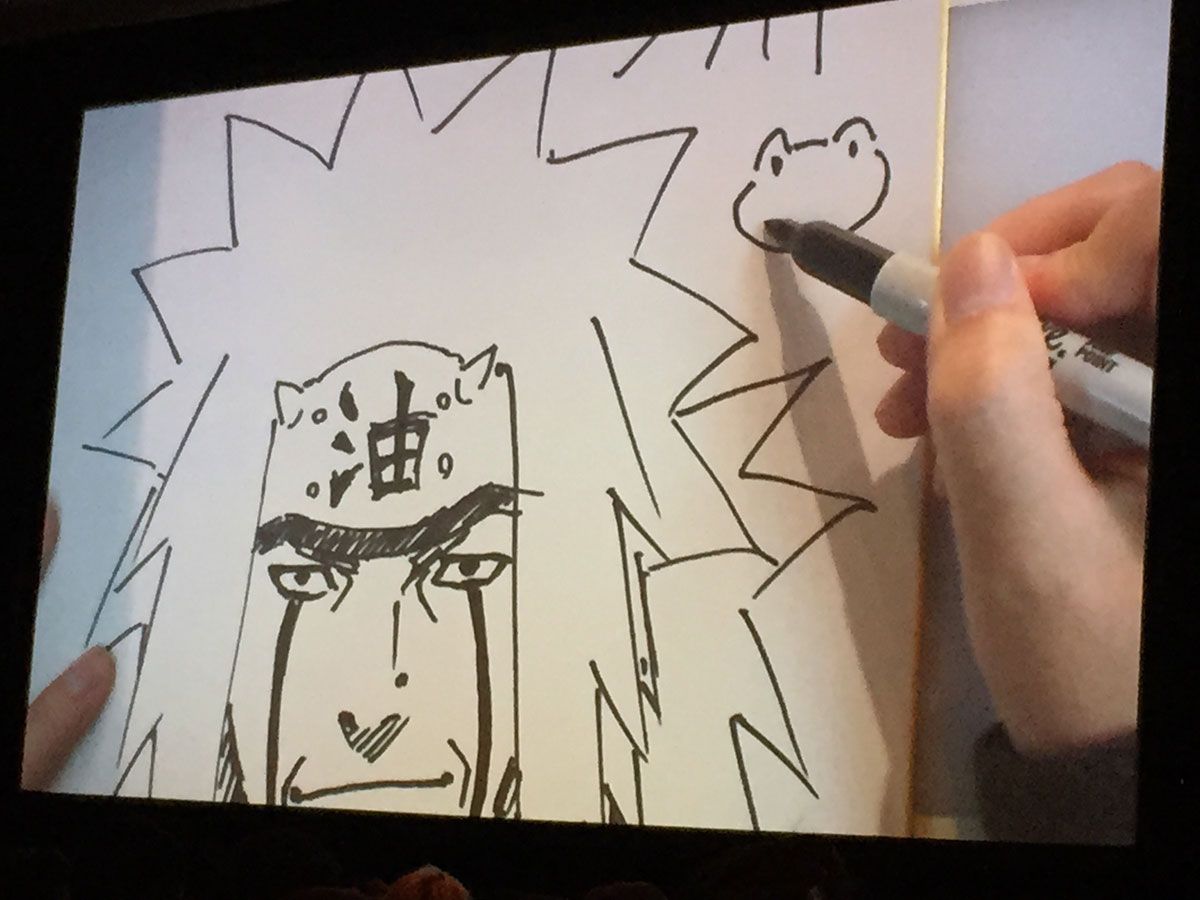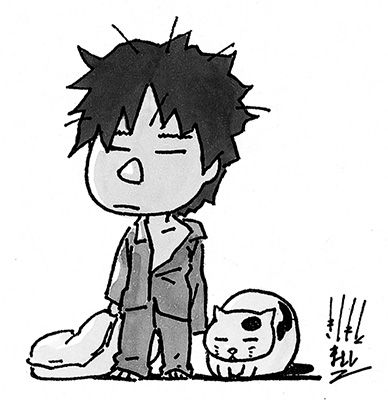Over 2,000 fans filed into the Main Stage theater of the Javits Center for Masashi Kishimoto's New York Comic Con debut with surprising precision. Volunteers led them in, single file, where they quickly filled one row at a time. It all would have seemed neat and orderly if it wasn't for the constant roar as the crowd cheered every comment from the warmup DJ. Not surprisingly, many of the fans who showed up to see the creator of "Naruto" were dressed as characters from the 72-volume manga; in fact, Kishimoto admitted at the end of the panel that he used one of them as the model for the onstage sketch he did of the character Jiraiya.
The crowd pitched in a lot in the course of the panel, whooping and cheering with just a bit of prodding from moderator Christopher Butcher, and collapsing into one loud "Aawwww" when Kishimoto admitted that with "Naruto" finished, he was finally able to spend time with his children.
Dressed in an open-necked light blue shirt and a grey jacket, Kishimoto looked relaxed, tossing out asides and jokes as the panel went on. He began by admitting that he never thought "Naruto" would go on as long as it did. "In fact," he said, "I thought it might get canned after the tenth week. That's actually a regular occurrence at ['Shonen] Jump,' that if the fan reaction is not very good, episode 10, the end," he punctuated by making a slashing motion across his throat.
RELATED: "Boruto" Becomes Top-Grossing Film In "Naruto" Franchise
"Naruto," of course, was a best-seller in both Japan and the U.S., and Butcher wondered if Kishimoto didn't have the opposite problem, that the editors of "Shonen Jump," the magazine that published the series in Japan, might not want it to end. "I would be lying if I said that there wasn't some pressure from management," Kishimoto replied. "But I had a pretty clear idea of how I wanted the story to come to a close, and I had to put my foot down and say, 'No, I'm sorry, this is it.'" The crowd roared their approval.
"In every good shonen story, there is the hero and the rival," Butcher said. "It's very clear that your rival is [Eiichiro] Oda-sensei, creator of 'One Piece.' How does Oda-sensei feel now that his rival has stopped his making rival manga series?" (The Japanese honorific "sensei," or "teacher," indicates the speaker's respect for the person being spoken of.)
"Honestly it is interesting," Kishimoto replied. "I was just saying that on my own in the beginning, and finally in the back of volume 72 [of 'One Piece'], Oda-sensei acknowledged the fact that he considers me his rival as well, and that felt so gratifying. Of course 'One Piece' and 'Naruto' ran together for so long, and even in Japan they ran in 'Shonen Jump' together. Sometimes we would meet up and say, 'I wonder how long our mangas are going to go on?' Of course, 'One Piece' kept going and going, and when I finally said, 'Well, actually "Naruto" is going to be concluding soon,' it gave him the awareness that 'One Piece' may conclude sometime in the future, too."
"Naruto" was at one time the best-selling comic in the U.S., and several volumes actually made the non-graphic novel best-seller lists. This seemed to come as a surprise to Kishimoto, who said, "I actually just found that out."
Kishimoto's first inkling of the overseas popularity of "Naruto" came when his editor started bringing him batches of fan mail that he couldn't read, because the letters weren't in Japanese. "I really was thinking about trying to make heads or tails of the foreign fan letters I received, and I gave up on that. But I want to think they are all positive," Kishimoto said, adding that he was more sure of the reports of his manga's popularity once he saw how many "Naruto" cosplayers there were all over the world.
Butcher called out for everyone in the audience who was wearing a Naruto headband to raise their hands. "Did you ever think about the cosplay-ability of the character designs?" he asked.
RELATED: "Naruto" Creator's Next Project Will Be A Sci-Fi Manga
"Not at all," Kishimoto said. "In fact, I actually feel like a lot of my characters might not be so easy to cosplay. In fact, to all of you out there who raised your hands saying you had headbands on, I feel really bad, and I kind of feel remorse, because -- are you sure you don't have a rash, with the headband rubbing against it and chafing at all?"
"You guys all right with the headband?" Butcher asked the audience, who roared back their approval.
Kishimoto said it was always his dream to have a series in "Shonen Jump," because he grew up during the "golden age" of the magazine, when it was running series like Akira Toriyama's "Dragon Ball," Buronson and Tetsuo Hara's "Fist of the North Star," and Masami Kurumada's "Saint Seiya." "I read these in real time, every week while I was growing up," he said. "[Being published in 'Shonen Jump'] was sometimes far off, but always a goal I wanted to achieve."
While that was the golden age of "Shonen Jump" in Japan, Butcher pointed out that the magazine wasn't available in North America at that time. When Viz started publishing the American version of "Shonen Jump," it serialized "Dragon Ball," "Naruto," "One Piece" and "Bleach," "lots of long-running series that changed the face of comics in North America. I think your era of 'Shonen Jump' could be considered a new golden age. What do you think?"
"You know, it reverberates very happily within me, even though I am kind of embarrassed, because I feel ashamed to say this in front of my mentors, the people that I consider the gods that came before me," Kishimoto said. "Then again, they are not here, so maybe I can call that the golden age here, of 'Jump.'" The crowd roared its approval.
As Kishimoto did two sketches for the audience, Butcher spoke with "Shonen Jump" editor, Jo Otsuki, the current editor of "Naruto." " In that series, even the worst character, no matter how bad they are, how evil they are, they get redeemed in some way," Butcher noted. "They are sympathetic. They are understandable... I'm really curious about where that comes from."
The answer, Otsuki said, is that Kishimoto carefully thinks through every character. "When each character first appears, or even before that, sensei has very carefully laid out what he wants each character to be, what his personality traits are, what has he done, what he is about to do, a complete personal history and background of each and every character, whether they be good characters or evil characters, or villains." The result is well-rounded characters, not just "flat images on paper."
Kishimoto finished his second drawing, of the character Jiraiya, to cheers from the crowd, and then he made a confession: "It's the first time in a while that I actually drew Naruto or any character from 'Naruto,' so I had a bit of nostalgia. I have to embarrassingly admit I don't quite remember how to draw Jiraiya, and I tried to look it up [on my phone], but I couldn't connect to the WiFi, so in fact I used the Jiraiya cosplayer in the audience. So thank you, Jiraiya cosplayer, for saving me!"
Butcher asked Kishimoto why he had described "Boruto: The Naruto Movie," which had its North American premiere at NYCC, as "the pinnacle of my career."
"This was the first time I actually had been able to work on a screenplay from beginning to end," Kishimoto answered. "The story is essentially something I wanted to draw as a manga, but didn't have the opportunity to. I was really able to make the story and the characters what I wanted to see done, and then had the honor to have the anime come to life. I envisioned this as the last chapter of 'Naruto.'"
Kishimoto ended the panel by thanking his fans. "I heard that there were many fans that couldn't even make it today," he said. "To hear that, after seeing how many people are really here -- this is just a little title that I started working on many years ago without ever thinking about any impact that it might have, much less globally. All I can say is, to know how many of you, how many fans love my work, and have followed my work, I am just so grateful. The only thing I can think of saying is, 'Thank you.'"



